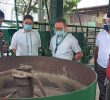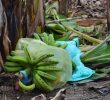Government may yet transform the abaca industry into a big foreign exchange earner if it can rationalize the sub-sector and make it a producer of manufactured goods and not merely a supplier of raw materials.
In order to gain much from the industry, the Department of Agriculture (DA) must encourage the expansion of existing plantations and encourage local entrepreneurs to pour in capital for the production of finished products.
Central to this expansion is the development of virus-resistant abaca varieties, according to the DA biotechnology program office (BPO) director Alicia Ilaga.
She noted that with the shift to natural fibers, manufacturers could earn a windfall by using abundant labor in Bicol, Eastern Visayas and Mindanao to provide importing countries with a variety of products apart from rope, pulp and fibers.
Ilaga stressed that for 2005, abaca was cultivated only in 135,958 hectares in several regions.
Based on the total agricultural area of 11.93 million hectares from 1970 to 2005, the hectarage is a puny 1.25 percent.
Official data show that abaca growth in Bicol on the average expanded by a paltry 1.8 percent, the biggest such growth from 1996 to 2005. Abaca area expansion in the Bicol region had an annual average of 36.7 percent, superior to Eastern Visayas’ 30 percent.
Despite the Bicol region’s dominance as far as hectarage is concerned, infestation by the buncy top virus caused a 1.7 percent decrease in production compared to Eastern Visayas, which increased by almost 6 percent.
Another factor that prevents the rapid expansion of growth in yield in Bicol is the low price of abaca, which compels farmers not to harvest the fiber when the price is low.
In contrast, Eastern Visayas farmers enjoy higher prices, and this has motivated them to plant more abaca.
Abaca fiber production from 1996 to 2005 averaged only 69,110 metric tons (MT). Eastern Visayas actually took the leadership in abaca fiber production during those years, accounting for 40 percent of output. Bicol followed at 29.4 percent.
As an immediate solution to the three viruses crippling the country’s abaca industry, Fiber Industry Development Authority (FIDA), in collaboration with state colleges and universities (SCUs), and local government units (LGUs) worked on disease control regulations.
They also encouraged the participation of farmers and private sectors to battle the diseases. Farmers’ field schools (FFS) disseminated biological control strategies and the tools needed.
One important tool that they developed was a disease map that served as a guide in assessing and analyzing the spread of the disease.
Disease surveillance and eradication in severely affected abaca areas were undertaken by FIDA technicians by cutting down infected plants, spraying insecticides and applying glyphosate, a herbicide that kills remaining abaca mats.
In spite of all the efforts to abolish the further outbreak of the disease, such measures cannot be sustained due to the limited government resources and field workers.
The herbicides and insecticides’ harmful effects on people and the environment were also considered and many farmers have opted not to use them. (biolife news service)










